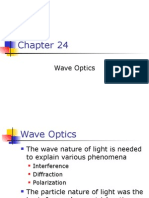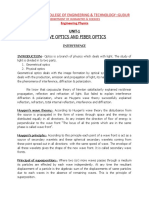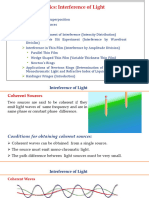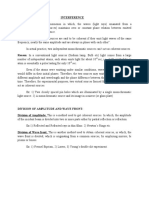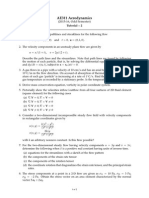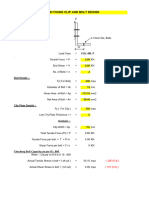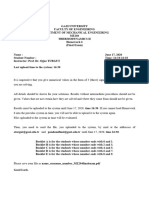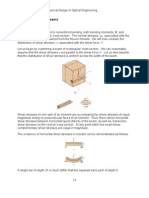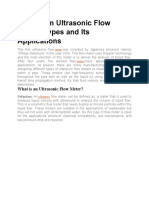ICET Module II Interference & Diffraction
INTERFERENCE
When two or more light waves of the same frequency and amplitude with a constant phase difference
travel in the same direction, superimpose upon each other, the resultant intensity of light is not distributed
uniformly in space. This non uniform distribution of the light intensity due to the superposition of light
waves is called interference.
Principle of Superposition of Waves
When two or more light wave travels simultaneously in a medium, the resultant displacement at any
point is the vector sum of the displacement due to each wave. This is the principle of superposition of waves
and this forms the basis of interference.
Consider two waves travelling simultaneously in a medium. At any point, let 𝑦1 be the displacement
due to one wave at any instant and let 𝑦2 be the displacement of the other wave at the same instant.
Then resultant displacement is 𝑦 = 𝑦1 ± 𝑦2 . Here + ve sign is taken when both waves are in same direction
and –ve sign is taken when both waves are in opposite direction.
Constructive and Destructive Interference
When two light waves superimpose at points where crest falls on crest and trough falls on trough, the
amplitude adds up and intensity of light increases. [intensity (Amplitude)2 ]. This is known as
constructive interference. i.e., The superposition of waves resulting in maximum intensity is called
constructive interference.
When two light waves superimpose at points where crests falls on trough or trough falls on crests,
amplitude are reduced (i.e., resultant amplitude is zero). This is known as destructive interference. i.e., The
superposition of waves resulting in minimum intensity is called destructive interference.
So when two or more light waves interfere, we get alternate dark and bright bands of equal width.
These bands are called interference fringes.
Condition for constructive interference
When the path difference between two interfering beams is either zero or integral multiple of , constructive
interference occurs.
Hence path difference = n where n = 0, 1,2, 3,……
Phase difference = 2n where n = 0, 1,2, 3,……
Condition for destructive interference
When the path difference between two interfering beams is odd multiple of , destructive interference
2
occurs.
Hence path difference = (2n+1) 2 where n = 0, 1,2, 3,……
Phase difference = (2n+1) where n = 0, 1,2, 3,……
1
�ICET Module II Interference & Diffraction
Condition for sustained interference
The two light sources must be monochromatic, they must emit light of same wavelength or
frequency.
The two sources must be coherent.
The two sources must be very close to each other.
Light waves from the two sources should superimpose at the same point and at the same place.
Optical Path
The distance travelled by light through a medium is optical path.
Optical path = geometrical path × where is refractive index. For air, = 1.
Relation Between Path Difference and Phase Difference
P
The difference between optical path of two rays
which are in constant phase difference with each other 𝑆1
is known as path difference. In the figure, path
Q
difference between light waves emerging from
𝑆2
two sources 𝑆1 and 𝑆2 is = 𝑆2 𝑃 - 𝑆1 𝑃
2π
Phase difference () = × path difference (𝑥)
λ
Interference in thin films – Reflected system
We see beautiful colours on oil films or soap bubbles. This is due to interference phenomenon involving
multiple reflections. Here the method involved is interference by division of amplitude. The light reflected
from the upper and lower surfaces of a thin film interferes and interference patterns are produced.
Interference due to reflected light
Consider a thin film of thickness ‘t’ and refraction index . Let light from a monochromatic source be
incident on the surface of the film. Reflections takes place from the upper and lower surface of the film.
E
Optical path difference between two beams is D
F air
(AB + BC) in film - AF in air
i
Since AB = BC, 90-i i
A N C
Optical path difference = (2AB ) AF (1) r
r t
To find AB, denser medium
BN 𝑡 B
Consider ABN, cos 𝑟 = AB =
AB
𝑡
So, AB = (2)
cos 𝑟
2
�ICET Module II Interference & Diffraction
To find AF, consider AFC
AF = AC sin 𝑖 (3)
We have, AC = 2 AN
To find AN, consider ABC
BN 𝑡
tan r = AN =
AN
AN = t tan 𝑟
Therefore, AC = 2 t tan 𝑟
Hence eqn (3) becomes, AF = 2t tan 𝑟 sin 𝑖
sin 𝑖
By Snell’s law, = ; sin 𝑖 = sin 𝑟
sin 𝑟
sin 𝑟
Hence AF = 2t tan 𝑟 sin 𝑟 = 2t sin 𝑟
cos 𝑟
sin2 𝑟
AF = 2t (4)
cos 𝑟
Substituting eqn (3) and (4) in eqn (1), we get
2𝑡 sin2 𝑟 2𝑡 2𝑡
Optical path difference = 2t = (1 − sin2 𝑟) = ( cos 2 𝑟)
cos 𝑟 cos 𝑟 cos 𝑟 cos 𝑟
Optical path difference is 𝟐𝒕 𝐜𝐨𝐬 𝒓.
This is known as Cosine’s law.
When light is reflected from the surface of an optically denser medium, like the air film interface,
then the reflected rays undergoes a path change of 2 . (This is in the case of reflection only.)
Then the actual path difference is = 2tcos 𝑟 2
Condition for constructive interference
2tcos 𝑟 = n where n = 1,2,3…….
2
2t𝐜𝐨𝐬 𝒓 = (2n+1) 𝟐
Condition for destructive interference
2tcos 𝑟 2 = (2n+1)2 where n = 1,2,3…….
2t𝐜𝐨𝐬 𝒓 = 𝒏
Colour of thin films
When a beam of white light is incident normally on a thin film, different colours are seen. This is due
to interference involving multiple reflections. The condition for destructive interference is 2tcos 𝑟 = n. At
any region of the film, the colour with the wavelength which satisfies this condition will be dark .
For example, if blue colour satisfies this condition, blue colour will be absent and a combination of
other colours will be seen at that region.
3
�ICET Module II Interference & Diffraction
If the thickness of the film varies continuously in the case of oil film, the colour of the film continuously
changes.
If we observe the film from different positions, the colour of the film will be varying as the angle of
refraction r changes.
If the thickness of the film t is very small (t = 0), then destructive interference occur due to the additional
path difference of and film appears dark. If ‘t’ is very large, almost all the colours will undergo
2
constructive interference and white light is produced. Only a thin film of a few wavelengths thick, alone will
show different colours.
The condition of brightness and darkness in the reflected system and transmitted system are opposite to
each other.
Air Wedge
A wedge shaped film is constructed using two glass plates with one end placed in contact and the
other end separated by a thin paper or wire of thickness ‘t’. A wedge shaped air film is formed between
them. When the film is illuminated normally by monochromatic light, interference occurs between the rays
reflected form the top and bottom surfaces of the film. As a result, a large number of equidistant parallel
dark and bright bands are observed.
The spacing between two consecutive dark or bright fringes is called band width.
Interference produced by wedge shaped films
When the film is illuminated normally by monochromatic light, interference occurs between the rays
reflected form the top and bottom surfaces of the film.
Let ‘t’ be the thickness of film at a distance x from the edge.
t
We have path difference between two rays = 2𝑡 cos 𝑟
For a normal incidence, r = 0 (i.e., cos 0 = 1) , x
Then path difference between the rays is = 2t (1)
From figure, t = x tan (2)
Putting (2) in (1), we get = 2 x tan
The condition for destructive interference in thin film is 2 x tan = n where n = 0,1,2,3 ……
𝑛
or x= (3)
2 tan
If x1 is the distance of the nth dark band from the edge and x2 is the (n+m) th dark band,
𝑛 (𝑛+𝑚)
then x1 = and x2 =
2 tan 2 tan
4
�ICET Module II Interference & Diffraction
(𝑛+𝑚) 𝑛
𝑥2 𝑥1
2 tan 2 tan 𝑚
Then band width = = =
𝑚 𝑚 2 𝑚 tan
Band width = (4)
2 tan
Since for air film, = 1, = (5)
𝟐 𝐭𝐚𝐧
Since angle of wedge () is too small, then tan = , then = (6)
𝟐
The same relation holds good for bright bands also. Since the locus of all points having same thickness of
the film being a straight line, we get straight line fringes.
Applications
Diameter of a thin wire
A thin wire is wound near one end of a plane glass plate. It is kept over another plane glass plate so
that they touch along one edge and a wedge shaped air film is formed between them. The experimental
arrangement for determining the diameter of the wire is as shown in figure.
M
When a parallel beam of monochromatic light is made to fall normally,
we can observe a large number of straight parallel alternate bright and
dark fringes using a microscope. S
Let ‘d’ be the diameter of the wire and ‘l’ be the length of the wedge, then,
d d
tan = (1)
𝑙
l
𝑙
Band width = = d = (2)
2 tan 2 ⁄ 2d
𝑙
𝒍
Diameter of thin wire, d = (3)
𝟐
Testing of planeness of surfaces
Air wedge experiment can be used to test the optical planeness of surfaces. The surface to be tested
is used as one of the plates in air wedge experiment. The other will be a standard plane surface. If the
surface is optically plane, then straight fringes of equal thickness are observed. If the fringes are non
uniform and distorted, the given surface is not optically plane.
1 th
A surface is said to be optically plane, if it is flat up to 10 of the wavelength of the light used. With
1 th
the air wedge experiment, a flatness of a surface up to of the wavelength of the light used can be
10
determined.
5
�ICET Module II Interference & Diffraction
Newton’s Rings
When a plano convex lens is placed on a plane glass plate, with its convex surface touching the plate,
an air film of gradually increasing thickness is formed between the two. Light reflected from the top and
bottom surfaces of the air film between lens and the glass plate interferes to produce interference pattern.
The thickness of the film is zero at the point of contact at O and increases radially outwards.
The thickness of the air film will be constant over a circle and the pattern consists of concentric bright and
dark rings. These rings are called Newtons rings.
Newton’s rings consist of a set of alternate dark and bright rings with central
spot dark.
From the interference pattern, it can be seen that the centre spot is dark.
At the centre, i.e., at the point of contact, the thickness of the air film is zero. But the beam of light
gets reflected from the upper surface of the glass plate G and undergoes an additional path difference of .
2
This results in destructive interference. Hence the central spot is dark.
Experimental arrangement for Newton’s rings:
Light from a monochromatic source S is allowed to fall on a glass plate kept at 45 to the incident
beam. This beam is reflected normally on to the planoconvex lens L placed on a glass plate G.
L
Air film
G O
Light rays reflected from top and bottom surface of the air film interferes. Circular bright and dark
fringes can be observed by looking through a travelling microscope focused on to the system.
The locus of points having the same thickness of the air film falls on a circle. Therefore fringes take
the form of concentric rings.
6
�ICET Module II Interference & Diffraction
Determination of radius of nth ring
Let DOA is the lens placed on the glass plate PQ. DOA is a part of the spherical surface with centre
C. Let R be the radius of curvature of the plano convex lens and rn be the radius of the nth ring. Let be the
wavelength of the light used.
The condition for minimum intensity in thin interference film is
C
2tcos 𝑟 = n (1)
R-t R
Since light is falling normally r = 0, and cos r = 1 and for air film = 1 B
D rn A
t
So equation (1) becomes 2t = n (2)
P O Q
In figure, from ABC,
R2 = 𝑟𝑛2 + (R − t)2 = 𝑟𝑛2 + R2 2Rt + t 2
Since t is very small compared to R, R2 = 𝑟𝑛2 + R2 2Rt
𝑟2
Or 𝑟𝑛2 = 2Rt 𝑛
i.e., t = 2R (3)
𝑟2
Substituting (3) in (2), 2 2R
𝑛
= n
Or 𝒓𝒏 = √𝐧𝐑 where n = 0,1,2,3….. for dark ring.
(2n1)R
Similarly, for bright ring, 𝑟𝑛 = √ where n is the order of the ring.
2
Determination of wavelength of monochromatic light used
Let D𝑛 and D𝑛+𝑚 are diameters of nth and (n+m)th dark rings respectively.
We have 𝑟𝑛 = √nR where R is the radius of curvature of the plano convex lens
Here, D𝑛 = 2𝑟𝑛
Hence diameter of nth dark ring is given by (D𝑛 )2 = 4(r𝑛 )2 = 4nR
2
Similarly, the diameter of (n+m)th dark ring is given by (D(𝑛+𝑚) ) = 4(𝑛 + 𝑚)R
2
Then (D(𝑛+𝑚) ) (D𝑛 )2 = 4𝑚R
2
(D(𝑛+𝑚)) (D𝑛 )2
Wavelength of the monochromatic light used = 4𝑚R
Determination of refractive index of a liquid
If a liquid of refractive index is introduced between the lens and the plate, path difference between
the rays is = 2t.
𝑟 ′2
The condition for minimum intensity in thin interference film is 2t = n and 𝑛
t = 2R where 𝑟𝑛′ is the
radius of the ring when liquid is introduced.
𝑟 ′2 𝑛R
𝑛
So, 2 2R = n or 𝑟𝑛′2 =
7
�ICET Module II Interference & Diffraction
4nR
Hence, diameter of nth dark ring when liquid is introduced is given by (d𝑛 )2 = and diameter
2 4(𝑛+𝑚)R
of (𝑛 + 𝑚)𝑡ℎ dark ring when liquid is introduced is given by (d(𝑛+𝑚) ) =
2 4𝑚R
Then (d(𝑛+𝑚) ) (d𝑛 )2 =
2 𝟐
(D(𝑛+𝑚) ) (D𝑛)2 (𝐃(𝒏+𝒎) ) (𝐃𝒏 )𝟐
Hence, 2 =
4𝑚R
4𝑚R or = 𝟐
(d(𝑛+𝑚) ) (d𝑛 )2
(𝐝(𝒏+𝒎) ) (𝐝𝒏 )𝟐
𝑛R
Since, 𝑟𝑛′2 = where 𝑟𝑛′ is the radius of the ring when liquid is introduced and 𝑟𝑛2 = 𝑛R is the
𝒓𝟐𝒏
radius of the dark ring, then = .
𝒓′𝟐
𝒏
(𝐃𝒏 )𝟐
Also, = (𝐝𝒏 )𝟐
. Since for liquid is greater than 1, 𝑟𝑛′ < rn . Hence we conclude that the rings contract
with introduction of a liquid.
Newton’s rings in white light
With white light, few colour rings appear near the point of contact. The radius of the rings depends
on wavelength. So bright rings of the same order for several colours will be seen with different
radii.
A few coloured fringes are observed around the point of contact. Due to the overlapping of the
higher order of fringes, the pattern disappears in the outer portion.
In transmitted light, there is a central spot which is bright and rings are less distinct.
Antireflection coating or nonreflecting films
Antireflection coating or non reflecting films are a type of coating applied to the surface of lenses,
and other optical instruments to reduce reflection.
It is a transparent dielectric material whose refractive index lies between refractive index of air and
that of glass. It should be equal to square root of the refractive index of the glass used.
Magnesium fluoride or cryolite is the most widely used material for antireflection coating. They are
usually deposited by vacuum evaporation technique.
A Non reflecting film
air
B
glass
Anti reflection coating
8
� ICET Module II Interference & Diffraction
a The incident light is reflected from the upper and lower surface of thin film with a phase change of
. If the thickness of the film is such that both the reflected rays are in opposite phase , they cancels
each other and the intensity of transmitted light is increased.









































